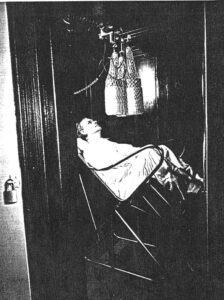In the 1950s AECL had a need for a low-background laboratory. Part of this need was to look for contaminants in food, originating from nuclear-bomb tests. Another was spurred by the need to check employees for possible accidental ingestion of radioisotopes in the workplace. The Chalk River Plant site was not ideal for this task since the operating reactors provided an interfering background from the decay of radioactive argon (41Ar). The solution was to build a laboratory in Deep River. The first lab was set up in one of the 14 buildings that existed in the area at the top of Ridge Road of which only the present Hill House remains. By 1956, a new laboratory was constructed on Poplar Avenue just uphill of the home of the Canadian Nuclear Heritage Museum. Betty Robertson, as a young mother juggling lab work with child-rearing duties, carried out many measurements there to determine the levels of contamination of radioactive cesium (137Cs) and strontium (90Sr) in milk and wheat samples from across the country. In 1958, G.C. Butler and G. Cowper wanted to measure the total body radioactivity of a person due to the natural amount of radioactive potassium (40K) which the heart and muscles possess as well as other radioactive materials that might have been ingested. To further limit the background from cosmic rays etc. they constructed an approximately 2-m cubic, shielded room having all sides, as well as floor and ceiling, made of 25-cm thick iron plates. (A quick calculation gives a total load on the floor for this room of more than 40 tons!). The person being studied would recline in a tilted chair in the room with a pair of large crystal detectors (probably sodium-iodide) hung above them for a period of 20 minutes during which a gamma ray spectrum was collected. G.C. Butler served as one of the first volunteers to test the apparatus. The results of one of the 20-minute-long scans show the expected gamma ray peak at 1.46 MeV from the decay of 40K but also an equally large gamma ray peak at 0.662 MeV from the decay of 137Cs, the “bomb-fallout” isotope. This laboratory continued to serve as a low background lab until the mid- 1970s when it was replaced by the Low background Building on the Chalk River site just inside the outer gate on the Plant Road, a large distance from the operating reactors. The town lab building was demolished at this point. While we must admit to being unsuccessful in finding any artifacts that were associated with the low-background lab, we did record a video-interview with Betty Robertson who described some of her work there. You can find it under “Interviews” at www.nuclear heritage.com

